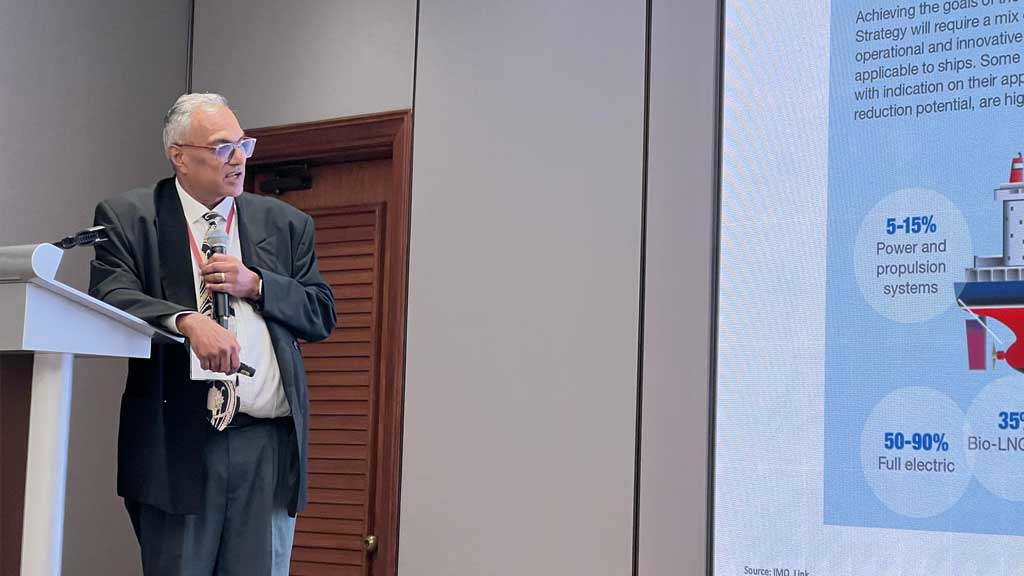
Maritime Energy Transition Towards Decarbonisation
On November 8, 2023, Dr. Sanjay Kuttan, Chief Technology Officer at the Global Centre for Maritime Decarbonisation (GCMD), gave the keynote address at the Asian Lubricants Industry Association (ALIA) Annual Dinner, which was held at the Conrad Orchard, Singapore. In his presentation Maritime Energy Transition Towards Decarbonisation, Kuttan provided an overview of various alternative fuels that could help in decarbonising the maritime sector; such fuels included biofuels, methanol, hydrogen, ammonia, electrification, and nuclear energy. He also spoke on how shipboard carbon capture (SBCC) and energy-efficiency technologies can be deployed on vessels in combination with the use of alternative, low/ zero-carbon fuels to reduce shipping’s GHG emissions.
Kuttan believes the revised IMO GHG Strategy targets, adopted by MEPC 80 in July 2023, will be “hugely challenging” and will require the entire sector to develop new perspectives for addressing the challenges. He shared results from the inaugural GCMD-BCG survey of 128 shipowners and operators to highlight the state of play in maritime decarbonisation.
A finding from the GMCD-BCG survey results indicates that 63% of the existing fleet of engines are unlikely to be retrofitted with future fuel capabilities because they are beyond 10 years old. Relatedly, a report by MAN Energy Solutions shows that green, zero-carbon fuels will likely not be available at the necessary scale by the end of the decade; 85% of the fuel mix for large merchant vessels will still be fossil fuels in 2030. Drop-in biofuels would make sense as an immediate, near-term solution. To validate this, GCMD has embarked on establishing an assurance framework for green fuels, an initiative that has focused on drop-in biofuels involving thirteen vessels bunkering at two ports to bolster the integrity of green fuels supply chain.
Kuttan noted the survey respondents felt positive towards ammonia as a marine fuel; 70% of maritime “frontrunners” plan to adopt ammonia as early as 2029. To this end, GCMD is helping ready the ecosystem for this new use case of ammonia through another of its initiatives, currently scoping pilots to demonstrate ship-to-ship transfers of ammonia within port limits to mimic bunkering operations before ammonia-fuelled vessels become available.
Kuttan also spoke of the industry’s growing interest in shipboard carbon capture (SBCC)—the process of capturing and storing carbon dioxide (CO2) emissions directly onboard a ship to mitigate environmental impact. 60% of survey respondents classified SBCC as “important” or “extremely important”, with 47% indicating that the technology being part of their company strategy or roadmap. On average, survey respondents expect SBCC to be commercially deployed by 2030.
SBCC involves a complex, interconnected set of elements. Some of the major, unresolved challenges include readiness of port infrastructure for offloading captured CO2 , its onshore storage, scalability of utilisation technologies, reliability of sequestration sites and policy instruments for carbon accounting, taxation and carbon credits, etc. Enabling SBCC requires operators to go beyond their current capabilities and partner with new players in the value chain to provide an end-to-end SBCC solution. Carbon capture technologies could be deployed on vessels in combination with alternative, low/ zero-carbon fuels solutions, says Kuttan, which is why GCMD commissioned a liquefied CO2 (LCO2) offloading concept study to address safety and operational considerations surrounding offloading of LCO2 captured on tankers, bulkers and containerships.
Kuttan also emphasised the role of energy-efficiency measures in reducing vessels’ overall energy consumption and GHG emissions. Technical and operational measures, such as wind-assisted propulsion, air lubrication, have been around, even though they are not uniformly adopted across the maritime sector, according to the GCMD-BCG survey. What is needed is for the industry to address and close the data-financing gaps to de-risk the use of such technologies, so that more will be incentivised to install energy savings devices onboard vessels.
There is no silver bullet for the industry, says Kuttan, complete greening of the maritime supply chain requires all value chain stakeholders to play their roles.



